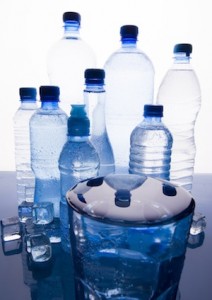There is much talk these days about all the shortages and crises we are facing, both now and in the immediate future. On this list of coming calamities, there is one that is definitely not getting the kind of publicity it merits, and that is the coming water crisis.
 The earth’s water system is basically closed, in the sense that the amount of water the planet holds stays the same all the time. While the water cycle is closed, however, human population and economic development cycles are not. The number of people on the earth is constantly increasing, and economic growth that inevitably increases the amount of water we use is a necessity for our current economic system to survive. It does not take an advanced degree in mathematics to calculate that if water usage is growing while supplies are constant, eventually we are going to have less water than we need to function individually and collectively.
The earth’s water system is basically closed, in the sense that the amount of water the planet holds stays the same all the time. While the water cycle is closed, however, human population and economic development cycles are not. The number of people on the earth is constantly increasing, and economic growth that inevitably increases the amount of water we use is a necessity for our current economic system to survive. It does not take an advanced degree in mathematics to calculate that if water usage is growing while supplies are constant, eventually we are going to have less water than we need to function individually and collectively.
The collective aspect of the problem is not for us to solve, but the individual part is going to test our initiative. From a personal perspective, one of the smartest things anyone can do to increase your access to adequate water supplies is to set up a rain capture system that will allow you to harvest the water that falls from the sky for your own use. Of course, when you begin to collect rainwater using the basic, time-tested design of gutter to spout to rain barrel to storage, it will be necessary in most cases to treat the water by filtering it before you can use it.
Gutter Screens
The first location where you will want to consider filtering your water is at the point where collection actually begins, where it runs off of the roof and into a gutter. Micromesh gutter screens are the product that is needed to perform this duty, as they will act to prevent any larger contaminants or debris from being washed into your gutter. Gutters of course have a tendency to become clogged and dirty, and gutter screens are your first line of defense against this unpleasant reality.
One highly recommended type of gutter screen is the Gutterglove, which has an impenetrable micro-screen made from surgical grade stainless steel and an anodized aluminum mounting system that will hold up through tumultuous storms and never rust from contact with other types of metal. You need something tough enough to catch and hold anything that might be washed in by a storm like broken pieces of tree limb, and the Gutterglove has received rave reviews for its unmatched strength. Leaf Solution is another micromesh gutter screen that uses surgical-grade stainless steel and aluminum, and like all the better gutter screens, it is self-cleaning, thereby eliminating the need to crawl up on the roof to clean it manually after every serious rainfall.
Downspout Filters
Downspout filters are usually located at the conjunction of gutter and downspout, although they sometimes can be installed closer to the spout outlet. These types of filters will catch smaller debris and particulates that may manage to get through the gutter screen – or are certain to get through if you elect not to use a gutter screen. Generally, downspout filters will catch anything that is an eighth of an inch across or larger, although this obviously varies, and naturally it is in your interests to find a filter that gets the smallest particulates possible.
The Aquabarrel Downspout Filter installs in-line on your downspout filter instead of at the gutter-spout intersection, which means it can be easily reached and cleaned. The removable filter basket is made from aluminum so its screens will never be ruptured, and the filter is designed to fit snugly and tightly so everything always stays in place. Quattro offers two good options – its regular Quattro Downspout Filter or the more sophisticated Twist Downspout Filter. These filters feature internal sieves for catching fine contaminants and are designed to fit either square or round gutters equally well. The Twist filter is self-cleaning, with a one-inch side flow outlet, and is great for use in summer or in winter when snow can become mixed in with rain. Both of these options come in different colors for those who have some aesthetic preferences for their rain collection system.
First Flush Diverters
One of the most important parts of your filtering system should be your first flush filter. When it first begins raining, any contaminants that have collected on your roof such as animal droppings, dirt particles covered with pesticides, or soot will be washed into your gutter to be carried along to your collection point. A first flush diverter is cleverly designed to divert the first water that enters the collection system so it will be prevented from reaching your rain barrel.
The Rain Harvesting First Flush Diverter uses a ball and seat system to divert and release the first water it captures, sealing itself afterwards so the collection process can commence. This diverter is ingeniously designed and accomplishes its task with little fuss. Another excellent product is the Fiskers 5962 Rain Barrel Diverter Kit, which has a removable filter and an improved capture system that is built to withstand the challenge of even the heaviest rainfall.
Potable Water Filtering Systems
If you want to actually drink rainwater, you face a filtering challenge greater than what a normal water filter is built to handle. Therefore, you need a filtering set-up that is ready to handle the heavier responsibility of making rainwater drinkable.
The Katadyn Drip Water Purification System might be considered the state-of-the-art option here, since it is the system that is used all over the world by relief agencies operating in parts of the world where contaminated drinking water is a huge health problem. This system can eliminate bacteria, viruses, and spores that are dangerous to human health and deliver an end product that is completely safe to drink. The Aqua Rain Water Purifier is another good system that relies on a ceramic filter to eliminate bacterial contaminants and a silvered carbon bed that absorbs pesticides and various organic chemicals. Ultraviolet light purifiers are a relatively new development that harness electromagnetic wavelengths to effectively kill microbial invaders; if you were to decide after investigation to go with this method of purification, the Atlantic Ultraviolet Corporation has high-quality ultraviolet filters available that come in different sizes, depending on how much water you will need to purify on a daily basis.
While investing in a good water filter can certainly allow you to convert rain water into something that can be safely consumed, there is a do-it-yourself option that can do the job just as well – sand. Not many realize it, but sand has amazing abilities to clean and purify water. What you will need are collection barrels that can be divided into three parts: a top part where the water enters, a middle part containing perhaps three or four feet of sand, and a collection area below where the water can seep through and be collected. The one limitation with a sand-based system is that it works slowly, so it may not be a good choice if you need a lot of drinking water quickly. But if your concern is having water that is clean and safe to drink, a sand filter system is really without peer.
Rain Water and You
Ultimately, what kind of filtration system you set up to clean and purify the rain water you collect will depend on how much time and money you are willing to invest, what you plan to use the water for, and how clean you would prefer it to be. Whether used for drinking, irrigating, bathing, or cleaning, however, there is no doubt that using properly filtered rain water is an excellent way to cut down on water bills, and to help yourself become more self-sufficient in anticipation of the water shortages that could be coming at any time.










